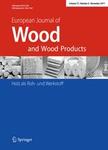版权所有:内蒙古大学图书馆 技术提供:维普资讯• 智图
内蒙古自治区呼和浩特市赛罕区大学西街235号 邮编: 010021

作者机构:Lulea Univ Technol Div Timber Struct S-95187 Lulea Sweden
出 版 物:《HOLZ ALS ROH-UND WERKSTOFF》 (木材)
年 卷 期:2004年第62卷第6期
页 面:455-464页
核心收录:
学科分类:082902[工学-木材科学与技术] 08[工学] 0829[工学-林业工程] 0805[工学-材料科学与工程(可授工学、理学学位)]
主 题:Timber
摘 要:Brittle failures in mechanical timber joints should be avoided, because this often results in low capacity and brittle failure of the structure. Nailed joints experience three ultimate failure modes: embedding, splitting or plug stear failure. To avoid plug shear failure, short and wide joints are preferred, limiting the number of fasteners in line with the load and grain direction. Plug shear failure was examined in short-term experiments on nailed steel-to-timber joints in glulam loaded in tension parallel to the grain with five different joint geometries. The aim of the study was to examine if the fastener group layout can be adjusted to avoid plug shear failure and to gain an insight into the causes of failure initiation. Using spring models, it is shown that the load distribution creates pronounced stresses at the last nail in the joint, which probably initiates the plug shear failure. Test results are compared with prediction models found in the literature. It was found that fasteners placed in groups can be a successful way of reducing the risk of plug shear failure. The failure is probably initiated at the nail farthest from the free end, where tensile stresses perpendicular to grain occur.